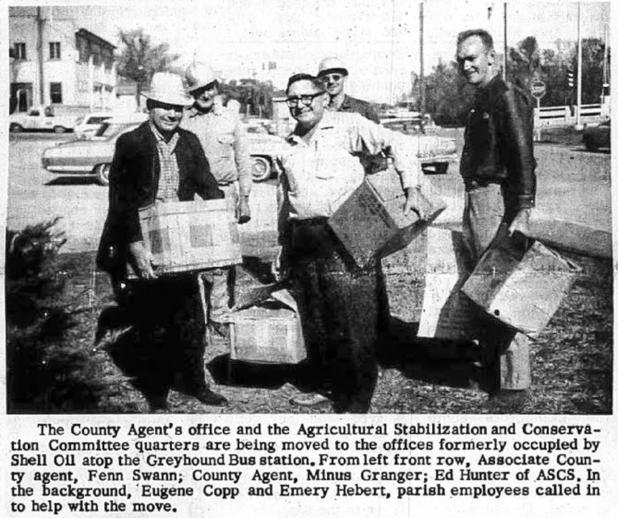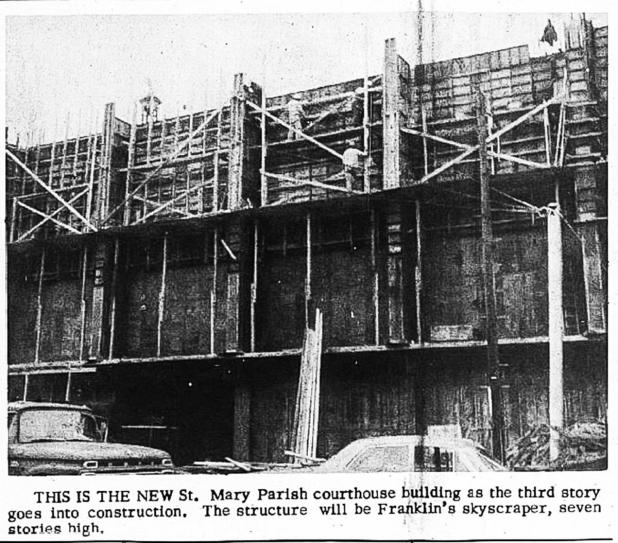
Moving to temporary accomodations

Present-day courthouse begins to emerge
The Old Courthouse Part III
(Editor’s Note: This is the third in a series)
The headline in the Banner-Tribune on Dec. 8, 1965 was: “Tax Election Passes.”
Voters approved the one-cent sales tax long-haggled over and as yet undecided solution to the St. Mary Parish Courthouse and jail issue.
The vote was 4,604 to 1,864 out of 18,000 registered voters.
The tax proceeds would also be split with the school board at 30 percent; the policy jury got 20 percent “to be used in capital improvements, buildings, waterway improvement, rural areas and to help build a new courthouse and jail,” the report reads. The five cities would split the remaining 50 percent.
On Jan. 1, 1966, the Banner reported: “Long before the sales tax passed on December 7 there was a question on the minds of some St. Mary citizens as to whether or not the parish police jury would carry through on construction of a new courthouse and jail. The 16 jury members answered emphatically this question Wednesday with a unanimous vote in favor of the new buildings, although agreement on a building site could not be reached.”
A $3 million bond issue was bandied about, but one juror said he had been told that a seven-story courthouse “was being constructed in Lafayette for a little over $2 million.”
It was also reported that “the state fire marshal has already condemned the present courthouse and if not torn down and rebuilt, the jury would have to bear the expense of maintaining the present buildings or the expense of demolishing them.”
As a side note, on Jan. 28, 1966, there was a front page article titled, “11 brass keys unlock cell doors at parish jail.” The following story states, “They’re as old as the jail, which makes them about 65 years old. Educated guesses say the jail was built about five years before the courthouse was constructed. That was in 1907-08.”
In February, 1966, the problem of the land upon which the courthouse and jail were erected rose again. According to found documents, the property was donated “…for the use and benefit of the people of the Parish of St. Mary…” by Alexander Lewis on May 5, 1814 and executed by Parish Judge Jehu Wilkinson. The agreement clearly indicated a courthouse and jail should occupy the site.
Whether or not that situation had any effect on the deliberations, it was reported on Feb. 6 that the courthouse committee “revealed that a location on land across the tracks from Foster Elementary School is under consideration.” Jurors asked for an appraisal of the present square and the proposed site in comparison. Further mention of that site is negligible.
Readers may recall the “Around Town” section of the newspaper in many years past, a sort of who’s-who and what’s-what submitted by readers and consolidated into a single article. On Feb. 25, 1966, the column included a snippet, “…Rita Robicheaux determinedly fighting courthouse termites with a spray can…”
It was not until May that the Banner ran a two-deck, eight-column headline above the flag: “Courthouse will remain on present site by 10-4 vote of St. Mary police jury.”
According to the report, Juror Joe Russo “extolled the advantages of a 30-acre tract of land said to be available in the Calumet area, despite the fact that it has been reiterated at almost all jury meetings where the new courthouse site has been discussed that a courthouse must be located, according to law, within the city limits of the country seat, in this case, Franklin.”
Consideration of the design of the courthouse was sought by the police jury in August, 1966 when they asked the Landmarks Society to study “a preliminary plan of the outside elevations” of the new building. Juror Lee Champagne said the group “was asked last week to make suggestions if it felt the design could better harmonize with the architectural style of this area.”
When this is done, architect Lloyd Guillory “will begin drawing a detailed working plan. Then the architect will draw up specifications and the police jury will be ready to advertise for bids.”
The school board agreed to rent space in the new courthouse, it was reported in August.
Guillory’s plans, as yet incomplete, were presented to the police jury in September, 1966. It would be “115,000 sq. feet of enclosed floor space in an eight story building with first level parking for 144 cars. It will exhibit masonry construction with weather conditioning and a helio-port atop the building. The outside will be basically grey bands of grey exposed aggregate around the bottom and top of the entire building.”
It is obvious that the Landmarks Society’s recommendations, if any, were not followed in the design presented. Perhaps prophetically, Guillory said that “some traditional minded persons in the area might not like the plan but it was in keeping with a modern and fast growing area such as St. Mary.”
Plans included three elevators, including the one for sheriff’s use only.
Nov. 18, 1966, the headline: “Courthouse model unveiled, building may start in March.”
Guillory unveiled a scale model of the new $3 million courthouse.
As predicted, “Some citizens were distressed over the lack of colonial style in the courthouse, but Juror Lee Champagne said the committee felt the building should reflect the progressive attitude of the people of St. Mary,” the reporter mentioned.
Even so, the design would have 20 times more usable space, and six times more actual floor space, standing 120-feet tall. “The building itself is designed to withstand 200 miles per hour winds; it has minimal glass usage and the reinforced concrete means few areas will need painting.” The ground floor parking was reduced to 22 spaces, with spaces for 55 on the bulk heading and 144 in the front plaza.
Police jury offices began to move out of the old building in December and into “the Blevins building (formerly the Bella building) where Shell Oil was headquartered several years ago.”
The $3 million in bonds were sold in January, 1967. Interest rate was around 4.75 percent. Meanwhile, “various offices in the present police jury building are in the process of moving above the Greyhound station,” the Banner reported.
Jan. 5, the front page featured three photos of police jury and other occupants moving out of the police jury building.
And on Feb. 2, the Banner reported that “three existing statues on the courthouse square will be used in the mall planned for the new building” including the Justice statue from atop the courthouse, Senator Donelson T. Caffery and the Confederate Soldier.
Today, we know that Justice was not relocated on the plaza, and is now at home in Grevemberg House Museum. Local citizens reportedly rescued Justice from the back of a truck on the way to the dump.
The police jury awarded bids to Horace B. Rickey Inc. of Lafayette for the new construction and Southern Steel Co. of San Antonio for structural steel in March.
Beginning March 21, the Social Security representative moved operations to the National Guard Armory.
Not much more was written on the subject for the rest of 1967. In February, 1968, the “Double Talk” column by Nora Lewis and Ella Mensman led off: “The builders of the new St. Mary Parish Courthouse seem to be adding insult to injury. That sheer grey wall staring us in the face has almost got us stir crazy and now we glance out and see a coat of black going on. If there’s anything we can’t stand it is black courthouses. Dickie Landry was in the office checking telephones and assured us that the black is tar to seal the grey concrete wall. When asked what they plan to cover it with he said, ‘Why, dirt of course, and flowers will be blooming al up the sides of the seven stories.’ Thoroughly satisfied, we all forgot the black wall and went back to work.”
Over the months that followed through most of 1968, the demolition of the structures surrounding the existing courthouse and subsequent beginning of construction of the new behind it were regarded as a curiosity, annoyance and in some cases, with disgust.
But there was also a bit of nostalgia, as Lewis and Mensman wrote: “You just oughta see how clean and sparkling (the old courthouse) is these days. We went into the rotunda election night and thought for a moment we had stumbled into the wrong building. Could it be that someone is feeling sorry for the poor, doomed old thing and trying to make its last days more comfortable?”
The first official act in the nearly complete new courthouse was in January, 1968, when Dan Winchester was sworn in as parish assessor by Clerk of Court Benny Blakeman. Winchester had asked to be the first.
June 27, 1968, and the headline proclaims: “Final session in court termed passing of era.”
The story went on, “Today marks the last session of court to be held in the old St. Mary Parish courthouse, soon to be demolished….Judge S.0. Landry said he feels like his losing an old friend for he has served on the bench for 30 years.”
Lafayette attorney J.J. Davidson said that “the architectural beauty and symmetry of the building which has symbolized the cause for justice for many decades, no gives way to the demands of progress and practical efficiency of modern times.”
The following Monday, offices and their workers began their move into the new, modern courthouse.
(To be continued)
